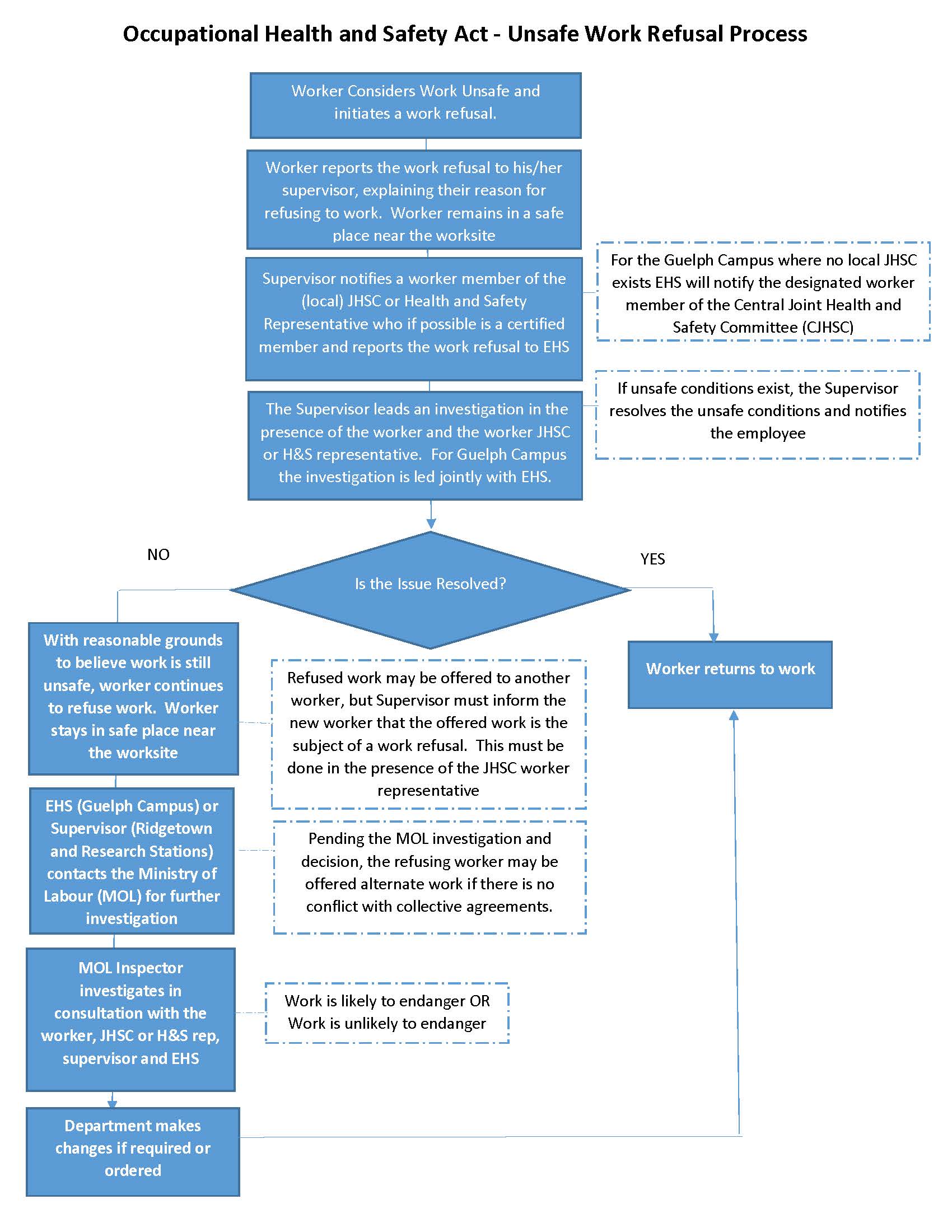Occupational Health and Safety Act (OHSA) Work Refusal
University of Guelph Workers have the right to refuse work that they believe is likely to endanger themselves or another. In such cases the worker must report the reason for the work refusal to his/her Supervisor and the Occupational Health and Safety Act (OHSA) Work Refusal Process must be followed.
No reprisals are allowed to be taken against any worker for exercising his or her rights under the Occupational Health & Safety Act (OHSA). This includes a workers’ right to refuse unsafe work.
Employees and Supervisors must distinguish this process for “OHSA Work Refusals” from the daily practice of due diligence associated with the recognition, reporting and correcting for workplace safety concerns and hazards.
Work Refusal Process under the Occupational Health and Safety Act (OHSA):
- Worker considers work unsafe and initiates a work refusal.
- The worker reports the work refusal to his/her supervisor, explaining their reason for refusing to work. The worker remains in a safe place near the worksite.
- The worker's supervisor must notify a worker member fo the (local) Joint Health & Safety Committee or Health and Safety Representative, who if possible is a certified member. The Supervisor must also report the work refusal to Environmental Health and Safety (EHS).
- For the Guelph Campus where no LJHSC exists, EHS will notify the designated worker member of the Central Joint Health and Safety Committee (CJHSC).
- For the Guelph Campus where no LJHSC exists, EHS will notify the designated worker member of the Central Joint Health and Safety Committee (CJHSC).
- The Supervisor leads an investigation, in the presence of the employee, a worker representative from the respective Joint Health & Safety Committee or Health and Safety Representative.
- For the Guelph Campus the investigation is led jointly by the Supervisor and EHS. For the Ridgetown Campus and Research Stations, the investigation is led by the Supervisor in consultation with EHS.
- If unsafe conditions exist, the Supervisor must resolve the unsafe conditions and notify the worker.
- For the Guelph Campus the investigation is led jointly by the Supervisor and EHS. For the Ridgetown Campus and Research Stations, the investigation is led by the Supervisor in consultation with EHS.
- If the worker has reasonable grounds to believe, work is still unsafe, and continues to refuse the work. The worker stays in a safe place close by the worksite and the Ministry of Labour (MOL) must be contacted.
- Refused work may be offered to another worker but the Supervisor must inform the new worker that the offered work is subject to a work refusal. This must be done in the presence of the JHSC or Health and Safety worker representative. The new worker may also refuse.
- Refused work may be offered to another worker but the Supervisor must inform the new worker that the offered work is subject to a work refusal. This must be done in the presence of the JHSC or Health and Safety worker representative. The new worker may also refuse.
- For the Guelph Campus EHS contacts the MOL for further investigation. For Ridgetown Campus and Research Stations the Supervisor contacts the MOL in consultation with EHS.
- Pending the MOL investigation and decision, the refusing worker may be assigned alternate work if there is no conflict with a collective agreement.
- Pending the MOL investigation and decision, the refusing worker may be assigned alternate work if there is no conflict with a collective agreement.
- The MOL Inspector investigates in consultation with the employee, JHSC worker member or Health and Safety representative, supervisor and EHS.
- The MOL Inspector issues a written decision to the University.
- Work is likely to endanger, OR
- Work is not likely to endanger
- The MOL Inspector issues a written decision to the University.
- Department makes changes if required or ordered.
- The worker returns to work.

Figure 1: Flow Chart of Work Refusal Process under the OHSA


